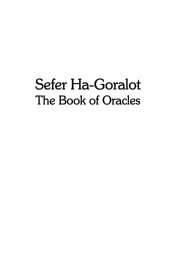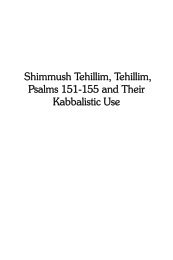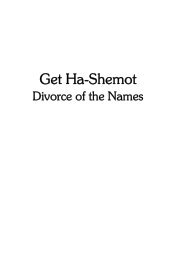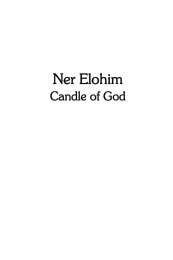Pardes Rimonim – Orchard of Pomegranates - EverburningLight.org
Pardes Rimonim – Orchard of Pomegranates - EverburningLight.org
Pardes Rimonim – Orchard of Pomegranates - EverburningLight.org
Create successful ePaper yourself
Turn your PDF publications into a flip-book with our unique Google optimized e-Paper software.
x<strong>Pardes</strong> <strong>Rimonim</strong> <strong>–</strong> <strong>Orchard</strong> <strong>of</strong> <strong>Pomegranates</strong>substance, materiality or physical limits. This is important,for the Sefirot are understood as God’s attributes; and justas the Deity is incorporeal, without material limitations orboundaries, so too are His attributes − the Sefirot.The second treatise is called “The Reason for theemanation”, consisting <strong>of</strong> 7 chapters. In chapter 1 <strong>of</strong> thistreatise, Ramak addresses Rabbi Yehudah 'Hayat’s critique<strong>of</strong> Rabbi Azriel’s statement − wherein he attempts toestablish the number <strong>of</strong> Sefirot as 10, while referring to aSefira as a point and ascribing to it geometrical dimension− that it has “…three dimensions, length, width, anddepth; and when you multiply it by itself, three becomesnine, which − together with the space that contains them− make ten”. The basis for Rabbi Yehudah’s criticism isthat dimension entails quantity; and since a Sefira is anattribute <strong>of</strong> God − Who is without the limits <strong>of</strong> dimensionor quantity − attributing dimension to a Sefira impliescorporeality in the Deity. Ramak brings further clarity to theissue by explaining that the Sefirot have no share inmateriality, but rather, after bodies are derived from them,then the “Sefirot are their [bodies] roots to which we applythe terms <strong>of</strong> materiality only by synonym”.In the third treatise, called “Is the Infinite Crown?”,Ramak speaks to the confusion displayed by somekabbalists who make the Upper Crown (Keter)synonymous with the Infinite (Ein S<strong>of</strong>), and by implicationmake Ein S<strong>of</strong> one <strong>of</strong> the 10 Sefirot. Ramak rejects thisnotion with support drawn from scripture and logic,arguing that the Emanator is essentially distinct from theemanation in that the emanated are subject to the limits <strong>of</strong>time. He says <strong>of</strong> the Deity that, “One <strong>of</strong> the things aboutthe Infinite is that it is impossible that He does not exist. Heis the necessary existent Who brought time into existence,











